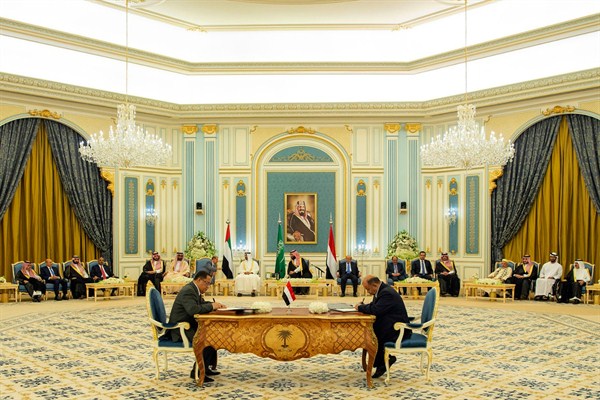After months of standoffs and halting negotiations, Yemen’s internationally recognized government signed a power-sharing agreement with southern separatists that, as the International Crisis Group put it, “has averted a war within Yemen’s civil war, at least for the time being.” The deal, brokered by Saudi Arabia and signed in Riyadh on Nov. 5, lays out the terms of a cessation of hostilities between President Abdrabbuh Mansour Hadi’s government and the separatist movement known as the Southern Transitional Council, or STC. Whether the agreement holds—let alone precipitates an end to Yemen’s devastating civil war and a new way forward for its southern movement—depends primarily on if its ambitious reforms can be fully implemented.
The breakthrough seeks to bring an end to armed confrontations in recent months sparked by longstanding tensions between Hadi’s government and the military wing of the Southern Transitional Council. The two groups have found themselves both strategic allies and wary adversaries throughout the course of Yemen’s civil war, a complicated dynamic that is rooted in a longer history of separatism in southern Yemen, which was an independent state until 1990.
In August, a missile launched from territory controlled by Houthi rebels near Sanaa hit a military parade in Aden, killing dozens, including an influential southern commander. The attack triggered widespread anger in southern Yemen, with the STC blaming it on Islah, a Hadi-affiliated Islamist political party. Four days of clashes ensued between the STC military wing, which is backed by the United Arab Emirates, and Hadi government forces, which are backed by Saudi Arabia, with the separatists reclaiming control over all government and military outposts in Aden. The STC takeover of Aden—which Hadi’s government fled to after the Houthis took Sanaa in 2015—not only exposed the growing rift between Saudi Arabia and the UAE as supposed coalition partners in Yemen, but also threatened to thrust the country into an even more intractable conflict pitting the Hadi government against southern separatists, in addition to Houthi rebels in the north.

